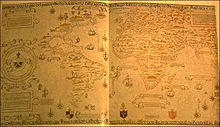- New World
-
For other uses, see New World (disambiguation).
 The World Map by Diogo Ribeiro (1529) labels America as MUNDUS NOVUS. It traces most of South America and the east coast of North America.
The World Map by Diogo Ribeiro (1529) labels America as MUNDUS NOVUS. It traces most of South America and the east coast of North America.
The New World is one of the names used for the Western Hemisphere, specifically America and sometimes Oceania (Australasia). The term originated in the late 15th century, when America had been recently discovered by European explorers, expanding the geographical horizon of the people of the European middle Ages, who had thought of the world as consisting of Europe, Asia, and Africa: collectively now referred to as the Old World.
Contents
Name origin
The Spanish scholar Peter Martyr d'Anghiera coined the term "New World"[1] with some twenty editions over the next four years.
In 1524, the term was also used by Giovanni da Verrazzano in a record of his voyage that year along the Atlantic coast of land that is now part of the United States and Canada.[2]
Usage and definition
The terms "Old World" vs. "New World" are primarily meaningful in historical context and for the purpose of distinguishing the world's major ecozones. One can speak of the "New World" in a historical context, e.g., when discussing the voyages of Christopher Columbus, the Spanish conquest of Yucatán and other events of the colonial period; additionally, the term "New World" is sometimes used in a biological context, when one speaks of Old World (Palearctic, Afrotropic) and New World species (Nearctic, Neotropic).
Criticism of term
The term has been criticized as being Eurocentric, patronizing and also for taking an apologetic tone with regards to colonialism.[3]
See also
References
- ^ de Madariaga, Salvador (1952) (in Castilian). Vida del muy magnífico señor Don Cristóbal Colón (5th ed.). Mexico: Editorial Hermes. p. 363. ""nuevo mundo", [...] designación que Pedro Mártyr será el primero en usar"
- ^ Verrazzano, Giovanni da (1524). "The Written Record of the Voyage of 1524 of Giovanni da Verrazzano as recorded in a letter to Francis I, King of France, July 8th, 1524". Citing: Wroth, Lawrence C., ed. (1970). The Voyages of Giovanni da Verrazzano, 1524-1528. Yale, pp. 133-143. Citing: a translation by Susan Tarrow of the Cellere Codex.
- ^ , (1970). . The New Press, pp. 65.
Continents Historical continentsArctica · Asiamerica · Atlantica · Avalonia · Baltica · Cimmeria · Congo craton · Euramerica · Kalaharia · Kazakhstania · Laurentia · North China · Siberia · South China · East Antarctica · IndiaSubmerged continents
Kerguelen Plateau · ZealandiaMythical and theorized continents
Atlantis · Kumarikkandam · Lemuria · Meropis · Mu · Terra AustralisSee also Regions of the world Regions of the world 
Africa Northern · Sub-Saharan (Central · Southern · Western · Eastern) 
Oceania Australasia (Australia) · Melanesia · Micronesia · Polynesia 
America North (Northern • Middle • Central • Caribbean) · South (Southern • Northern • Western) · Anglo · Latin 
Polar Arctic · Antarctic 
Asia Central · Eastern (Northeastern) · Northern · Southeastern · Southern (Indian subcontinent) · Western (Middle East) 
Oceans World · Arctic · Atlantic · Indian · Pacific · Southern 
Europe Central · Eastern · Northern · Southeastern · Southern · Western 
Seas List of seas Related Continents of the world · List of seas · Physical Earth Indigenous peoples of the world by continent Indigenous peoples by geographic regions Categories:- Americas
- Colonization of the Americas
- Culture of the Americas
- Oceania
- Geography of Oceania
- Oceanian culture
- Human geography
- Country classifications
Wikimedia Foundation. 2010.











